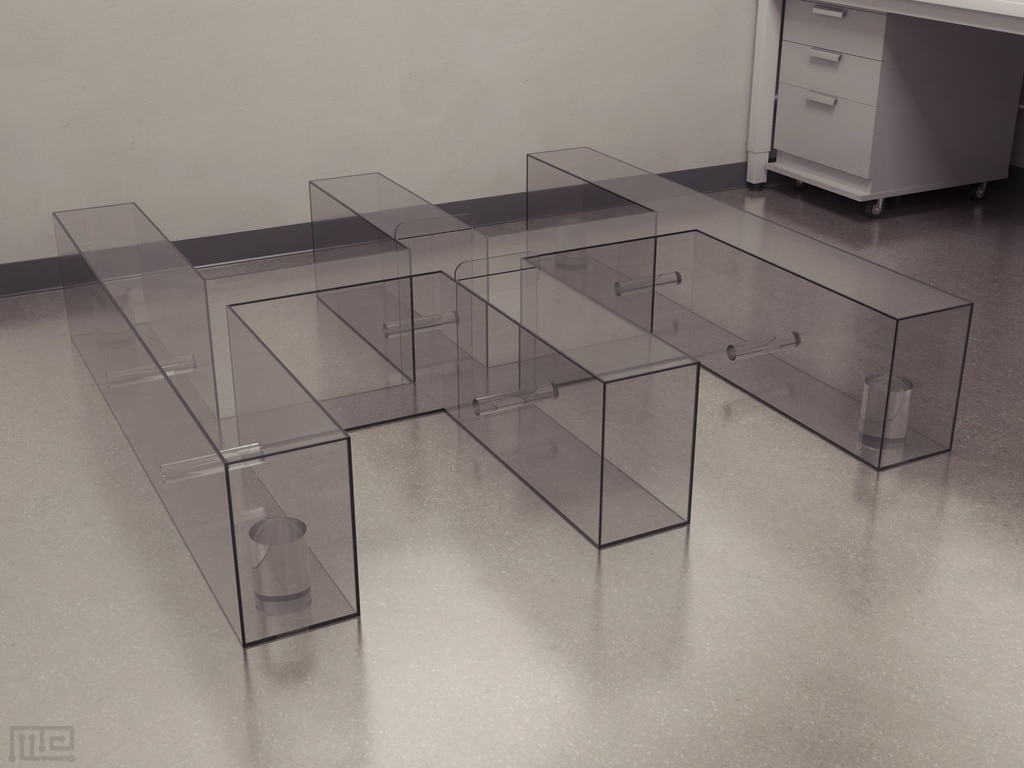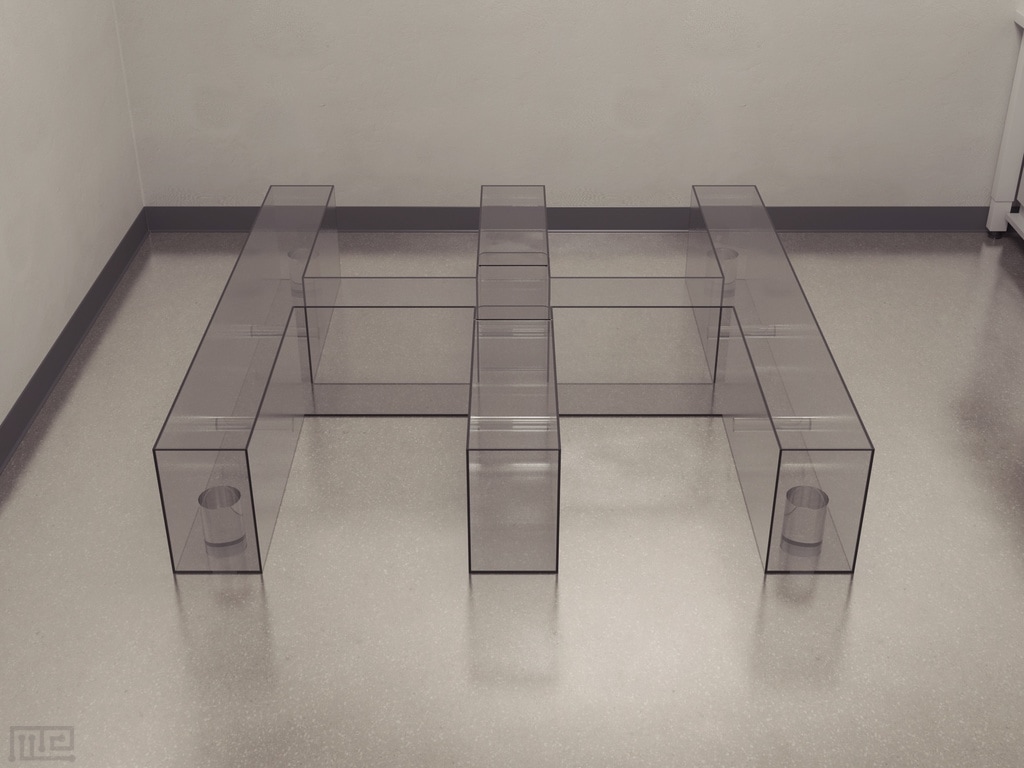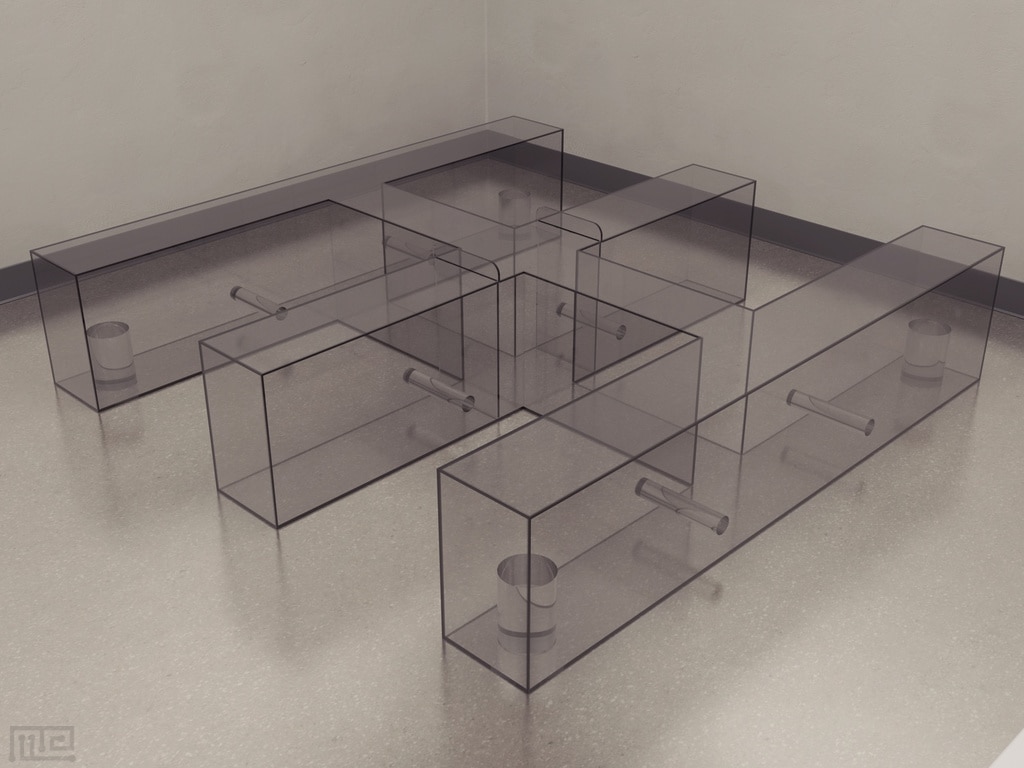The original utilization of the Double H Maze was as a novel spatial memory test to study the role of muscarinic or NMDA receptors in memory acquisition and procedural and declarative-like memory systems.(Pol-Bodetto et al., 2010). This maze is composed of transparent acrylic as double H shapes, with two opposite arms at each extremity and two arms in the centre flooded. Protocols using this maze favor allocentric navigation.
The MazeEngineers version of the Double H Maze is sized for both mice and rats and can be ordered in a variety of colors.
Price & Dimensions
Mouse
$ 2890
One Device- Length of three alleyways: 105 cm
- Width: 13 cm
- Wall Height: 24 cm
Rat
$ 3690
One Device- Length of 3 alleyways: 160 cm
- Width: 20 cm
- Wall Height: 35 cm
Documentation
Introduction
The Double H-Maze is a novel water-escape based task used in the evaluation of spatial learning and memory. In comparison to other spatial learning tasks, such as the Morris Water Maze or the Star Maze, the Double H-Maze allows the experimenter control over the strategy used by the subjects in the maze. The limited number of possible pathways between the start point and the goal in the Double-H Maze is how the investigator can control the search strategy of the subjects.
The Double H-Maze allows assessment of not only spatial learning and memory but also of behavioral flexibility and sensorimotor functions. The apparatus is quite useful in the study of neurological and neurodegenerative diseases that affect procedural or declarative memory systems. It can also be used to assess the competitive or cooperative interactions between these two memory structures, along with the factors that influence the interplay. The subjects can be trained to adopt an allocentric strategy by unpredictably alternating the start positions, forcing them to rely on allocentric cues to reach the goal. Similarly, an egocentric approach can be encouraged in the subject by initiating the task from the same start position. This enables the subject to learn the procedural patterns to reach the goal location.
Rodents make excellent animal models in these studies since they possess both the procedural and declarative memory systems. Utilizing the rodent models in the Double H-Maze task enables gaining of valuable insights into the underlying causes of the disorders and in the development of effective treatments.
The apparatus consists of three parallel arms that intersect a central alleyway. The maze is filled with water, and an escape platform is submerged at an extreme corner of one of the maze arms. The rodents are forced to swim and explore the maze to find the escape platform. Other spatial memory tasks include the Barnes Maze, the Radial Arm Maze, the Ziggurat Maze, and the T-Maze.
Apparatus & Equipment
The Double-H Maze apparatus is created using a 6 mm thick clear acrylic shaped as two contiguous H from the top view. The apparatus consists of a central alleyway (length 160 cm) that has three 160 cm long arms protruding perpendicularly on either side. Each arm is equidistantly spaced from each other. All the alleyways are 20 cm wide and have side walls 35 cm in height. Additionally, the arms are also equipped with guillotine doors to block them off when required. The goal platform is usually a cylinder of diameter 11 cm and height 14 cm. The entire apparatus is often placed at the height of 80 cm from the floor in a large room with contrasting cues.
Training Protocol
Prior to beginning the trials, the apparatus must be thoroughly cleaned, and fresh water should be used for new trials. The apparatus should be well lit from above. For tracking and recording, software and camera, such as the Noldus EthoVision XT, can be used. If any cues are to be used, they must be in a contrasting color to the walls around the apparatus or the color of the water. For convenience, it is recommended that the arms be labeled according to their positions as south (S), southeast (SE), southwest (SW), north (N), northeast (NE) and northwest (NW).
For all trials, the water is filled to a level that does not allow the subjects to touch the floor of the apparatus nor climb over the walls of the apparatus. In case the subject fails to reach the goal in the allocated time, gently nudge it towards the platform.
Pre-Training
Fill the apparatus with clear water and place the goal platform in the extreme corner of one of the goal arms such that it protrudes 1 cm above the water surface. Gently place the subject at one end of the central alleyway and initiate the training. Perform four consecutive 60 seconds trials. Once the subject has found the platform, let it stay on it for 15 seconds to rest and observe its surroundings.
Allocentric Strategy Training
Color the water in the shade contrasting to the subject to turn it opaque. Place the goal platform in an arm different from the pre-training and ensure that it is submerged 1 cm under the water surface. Place the subject in one of the two start positions, alternating the start positions for every trial in an unpredictable manner. Ensure that each arm is used twice in every session. Perform four trials per day.
Allocentric Probe Trial
Color the water in the shade contrasting to the subject to turn it opaque. Place the subject in an arm different from that used during training. Allocate 60 seconds for the subject to locate the goal platform.
Egocentric Strategy Training
Color the water in the shade contrasting to the subject to turn it opaque. Place the goal platform in an arm different from the pre-training and ensure that it is submerged 1 cm under the water surface. Use the same start position for all four trials of the session.
Egocentric Probe Trial
Color the water in the shade contrasting to the subject to turn it opaque. Remove the goal platform for this trial and block the opposite arm using a guillotine door. Place the subject in the same start arm as in training. Allocate 60 seconds for the subject to explore the maze.
Evaluation of the effects of systemic muscarinic or NMDA receptor antagonist on place learning
Adult, male Long-Evans rats were divided into 6 six groups corresponding to a drug/dose or a control treatment. The drugs used for the experiment were scopolamine methylbromide (ScoMBr), scopolamine hydrochloride (ScoHCl) and MK801 hydrogen maleate (MK801) injected at different doses during the training phase to evaluate the effect on place learning. Two testing paradigms were used: 2-day training and 4-day training. After one day rest period, the subjects were subjected to 60 seconds of drug-free probe trial in which the goal platform was removed. In both training scenarios, a dose-dependent alteration could be observed in acquisition or consolidation by the drugs. However, with sustained training, the drugs were no longer effective. (Pol-Bodetto et al., 2011)
Evaluation of effects of systemic muscarinic or NMDA receptor antagonist on procedural learning
The effects of different doses of scopolamine methylbromide (ScoMBr), scopolamine hydrochloride (ScoHCl) and MK801 hydrogen maleate (MK801) on procedural learning was evaluated using the Double-H Maze. Adult, male Long-Evans rats were divided into groups based on the drug and doses used. After administration, the subjects underwent 4 days of egocentric strategy training before undergoing a drug-free probe trial. The results from the task showed that subjects immediately switched from response learning-based to place learning-based behavior when the environmental cues were significantly different between training and probe trials. (Pol-Bodetto et al., 2011)
Evaluation of effects of translation and rotation shifts on response vs. place memory
Cassel et al. used adult, male Long-Evan rats to investigate the effect of translation and rotation of the start position on the response and place memory of the rodents. Rats were trained to adopt a procedural memory-based strategy to find the escape platform. Probe trials were carried out 24 hours after the training sessions. In the probe trials, the subjects the start positions were varied to a shift by 60-cm (translation) or a rotation of 180° corresponding to the start position. It was observed, based on the first arm choice and subsequent search of the goal, that after translation a significant majority of the rats showed response memory-based behavior while after rotation this behavior could only be observed in half of the rats.
Data Analysis
The Double-H Maze is used in the assessment of spatial learning and memory. The following parameters can be recorded using the Double-H Maze.
- Time spent in each arm
- Time spent in the central alleyway
- Time taken to reach the goal platform
- Time spent in target-arm
- Latency to initiate the task
- Latency to enter an arm
- Number of initial and repetitive errors
- Number of entries into an arm
- Distance traveled
- Swim path
An error is recorded when the subject swims in a segment (arm or central alleyway) that is in a direction opposite to the most direct route to the goal.
Plotting of these parameters on graphs allows comparison of sham versus disease model. Analysis of allocentric versus egocentric strategies is also possible using the Double-H Maze.
Strengths & Limitations
Strengths
The Double-H Maze is a novel apparatus that is efficient in the assessment of spatial memory and learning and locomotor functions. The apparatus allows the investigator with more control over the search strategy used by the subjects. This control over the strategy used is helpful in the assessment of drugs and treatments focused on only one of the memory systems (response- versus place-memory). In comparison to other spatial memory and learning tasks, the Double-H Maze is effective in comparing allocentric and egocentric behaviors. The cooperative and competing interactions between the two memory systems can be easily investigated using this apparatus. Further, the apparatus can be easily adapted to various requirements of investigations using modifications such as opaque walls, changing the water temperature or using bright lights. The apparatus can also be used as a dry maze to observe locomotor capabilities and other aspects of spatial learning and memory.
Limitations
Improper lighting set-up and water temperatures can affect the performance of the subjects in the Double-H task. It must be ensured that the subjects do not lack in sensorimotor functions since the task relies on the subject’s ability to swim to find the escape. Subject’s handling may also have an impact on the performances. Subject’s that are highly anxious or timid may not be suitable for the task. In comparison to some spatial learning and memory tasks, the Double-H Maze may be time-consuming and require more effort to administer.
Summary & Key Points
- Double H-Maze is a novel water-escape memory task.
- The apparatus consists of three parallel goal arms connected to a central passageway.
- The task can be used in the assessment of spatial memory and learning and sensorimotor function.
- In comparison to other tasks, the Double-H Maze offers investigators more control over the search strategy used by the subjects.
- Double-H Maze allows investigation of competitive or cooperative interactions between the allocentric and egocentric memories and the factors that influence these interactions.
- Subjects can be easily trained to adopt response- or place-based search strategy.
- Simple modifications such as guillotine doors, external cues, and opaque walls allow easy adaptation of the Double-H Maze for different investigations.
- Subjects chosen for the task should not have any severe motoric deficits.
- The Double H-Maze is frequently used in studies of neurological disorders and neurodegenerative diseases and their associated treatments.
References
Cassel, R., Kelche, C., Lecourtier, L., Cassel, J. -C. (2012) The match/mismatch of visuospatial cues between acquisition and retrieval contexts influences the expression of response vs. place memory in rats. Behavioural Brain Research. 230, (2), 333-342.
Kirch RD, Pinnell RC, Hofmann UG, Cassel JC (2015). The Double-H Maze: A Robust Behavioral Test for Learning and Memory in Rodents. J Vis Exp. (101):e52667. doi: 10.3791/52667.
Olton, R. S., Samuelson, R. J. (1976) Remembrance of places past: Spatial memory in rats. J Exp Psych. 2, (2), 97-116.
Paul, C. M., Magda, G., Abel, S. (2009) Spatial memory: Theoretical basis and comparative review on experimental methods in rodents. Behav Brain Res. 203, (2), 151-164.
Pol-Bodetto S1, Jeltsch-David H, Lecourtier L, Rusnac N, Mam-Lam-Fook C, Cosquer B, Geiger K, Cassel JC (2011) The double-H maze test, a novel, simple, water-escape memory task: acquisition, recall of recent and remote memory, and effects of systemic muscarinic or NMDA receptor blockade during training. Behav Brain Res. 218, (1), 138-151.




